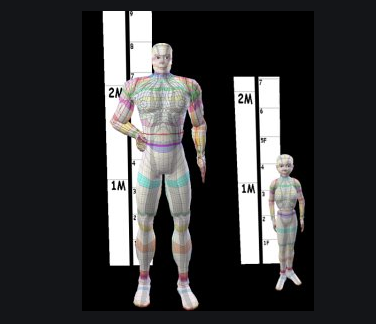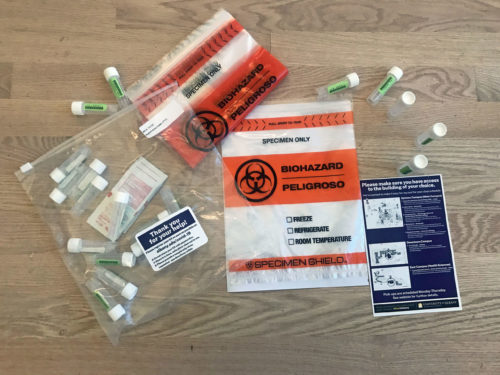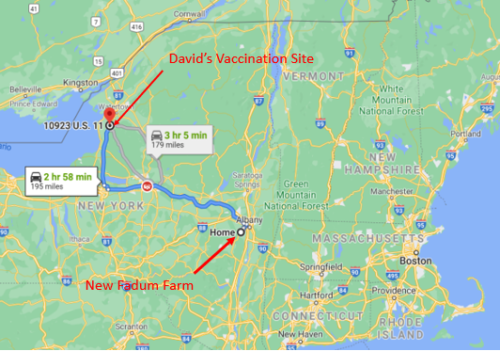One of the fun aspects working on this project with Ali, Dan, and Babak is that we get a chance to think out of the box, imagining new and interesting ways to confront the pandemic. Back on May 17 of last year (The Virus’s Tale: Ali’s Model Tells a Story) we got to imagine what the pandemic looks like from the point of view of the virus. This morning I wondered, what would happen to the pandemic if we could control how people behaved (that is, if everyone behaved just as we wanted them to).
To operationalize this idea, I imagined an avatar that we could insert into “Ali’s world”. We could instruct this avatar to behave in a mathematically precise manner. We can think of “Ali’s world” as a sort of cyber-reality embedded into his model. In this world, we could set things up so that all the people (call them “the crowd”) follow the lead of this avatar, acting in unison with regard to the epidemic.
Let’s give this avatar a name. I want to call her “EGO” because this name implies a strong sense of human agency. EGO has a strong and self-assured sense of what she needs to do in any given circumstance. We, the designers of Ali’s world, can set things up so that EGO always behaves in a mathematically precise fashion. Maybe EGO always wears a mask.; or maybe she only wears a mask 50% (or 58% or 78%) of the time. EGO always goes into quarantine when necessary; or maybe only half the time. The point is, if we can specify EGO’s behavior and “the crowd” follows her example, can EGO control the pandemic? Or does the pandemic control EGO?
This thought experiment intrigues me because I often feel like the pandemic is in control these days. We see the pandemic surging, receding and surging again in different parts of the country (and indeed, the world). We have seen this powerful force is kill hundreds of thousands of us and make millions more very ill. Sometimes it seems the pandemic is surely beyond our control. What chance would EGO have to assert control over such a powerful force?
It seems clear that EGO can control the pandemic in some extreme cases. We don’t really need Ali’s model to think through these cases. For example, what would happen if EGO gets vaccinated and everyone in the crowd follows suit (and assuming, of course, that the vaccine is highly effective)? That thought experiment is a no brainer—certainly, the pandemic would soon be extinguished. Similarly, if EGO and everyone else always goes into complete quarantine immediately whenever they become infected, it seems clear the pandemic would subside quickly— roughly in the time needed for all currently infected persons to either recover or die while in this perfect quarantine.
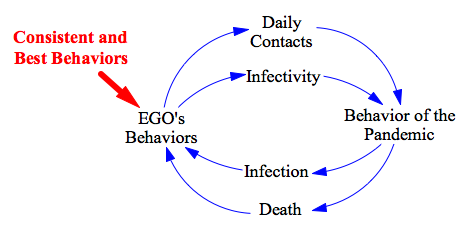
If EGO’s behavior is less extreme, the human population in the model cycles back and forth between behaviors that are capable of touching off a new cycle or turning back a surge at its peak. Figure 2 illustrates how EGO’s behavior creates a pattern of human contacts per day and person-to-person infectivity (because EGO does or does not wear a mask and social distance herself). Over time, the pandemic reacts to how EGO behaves by creating more (or fewer) infected persons and deaths. If we could direct our avatar, EGO, to hold true to consistent and best behaviors that turn back a surge, it seems that these behaviors would be able to turn back the pandemic permanently, assuming that the whole crowd goes along with EGO’s behaviors.
In the “Read More” section of the note below, we describe a computer experiment in which we directed EGO to “stay the course” as she was coming out of the second wave of the pandemic. From day X on, EGO consistently adhered to a consistent set of best behaviors, always wearing her mask and keeping social distancing. The results are clear. EGO can stay in control of the pandemic. If EGO holds to her best behaviors and most importantly if the crowd follows her lead, the pandemic is under control in under N days.
In Ali’s world, the avatar EGO is capable of controlling the pandemic. Why can’t we find a way to do the same in our external world? First, we need to think the thought so that we can then act the act.
This Story Has a Lesson
In Ali’s model we know that when the pandemic is surging, the population responds by reducing person-to-person contact and infectivity by taking measures such as wearing masks, maintaining social distancing, and in extreme cases going into lockdown. The human population is reacting to the virus. On the other hand, when the pandemic is receding (infections and deaths have declined) the population lets its response bounce back to its former state, thereby enabling a second or third wave. In these times, the pandemic is resurgent because of a loosening of control by the human population. There is a feedback loop here. The virus is driving population responses and in turn the population response both throttles and enables the growth of the pandemic depending on where we are in the cycle. There exists a fixed set of population responses that can break this cycle. The human population can regain full control of this pandemic when it finds and sticks to a set of behaviors that can and will bring the pandemic under control. Easier said than done.
Read More to Dig Deeper
To demonstrate how EGO can control the pandemic, we will need more than a simple thought experiment. We will need a computer-based simulation. Figure 3 shows what would happen in Ali’s world in three different assumptions about how EGO behaves. Before day 100, all three simulations show the same thing. Total persons infected (TOTINF) swells to about 1.3 million persons during the first wave of the pandemic. As illustrated in Figure 2 above, as the level of death and infection rises, EGO changes her behavior, lowering daily contacts (by staying home and wearing her face mask) and lowering overall infectivity (by maintaining social distancing and other safe behaviors). As a consequence of EGO’s changes in behavior, the pandemic responds by turning around at its peak and starting to decline.
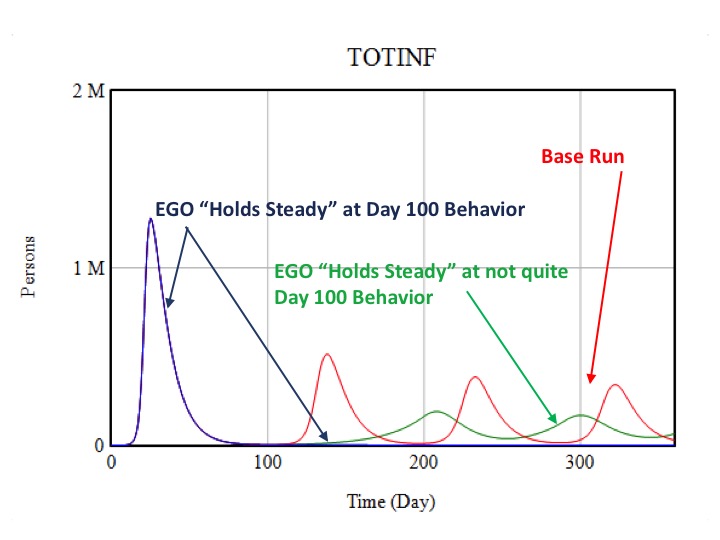
To demonstrate how EGO can control the pandemic, we will need more than a simple thought experiment. We will need a computer-based simulation. Figure 3 shows what would happen in Ali’s world in three different assumptions about how EGO behaves. Before day 100, all three simulations show the same thing. Total persons infected (TOTINF) swells to about 1.3 million persons during the first wave of the pandemic. As illustrated in Figure 2 above, as the level of death and infection rises, EGO changes her behavior, lowering daily contacts (by staying home and wearing her face mask) and lowering overall infectivity (by maintaining social distancing and other safe behaviors). As a consequence of EGO’s changes in behavior, the pandemic responds by turning around at its peak and starting to decline.
The Red line in figure 3 shows the Base Run behavior in Ali’s model. Prior to day 100, the Base Run curve was exactlly the same as in all the other runs. In this base run after day 100 as simuated Deaths and Infections start to decrease, EGO backs off of her more safe behaviors, letting her Daily Contacts and Infectivity drift back to their former levels. The consequence is that the pandemic moves into a second wave, but a second wave of lower amplitude. In the simulations shown in figure 3, there are four waves of infection as EGO repeatedly shifts her behavior between less and more safe, thereby enabling the pandemic to surge and recede
The Blue line in Figure 3 shows what would happen if at Day 100, EGO were to “hold steady” not changing her safety behaviors for the rest of the run. Prior to day 100, the Blue line shows the same erupting surge of the pandemic because EGO is still learning about the dangers of the pandemic. After day 100, the pandemic collapses to near zero and stays there for the rest of the simulation. EGO learned her lesson in the first wave and permanently changes her behaviors to the safer behaviors that she needed to get the pandemic to turn around at its peak. Of course, in this simulation, EGO got her whole crowd to exactly follow her lead by staying a the safe levels of Daily Contacdts and Infectivity. In real life, we do not know how to get an entire population to take such long term safe actions. We have seen approximations of these behaviors in isolated places with high social discipline such as Iceland, Norway, South Korea, or New Zealand, but so far maintaining such long-term social discipline has proven elusive in the United States and western europe.
The Green line in Figure 3 illustrates what happens in Ali’s simulated world when EGO is able to maintain a more constant level of Infecdtivity and Daily Contacts, but not quite enough to more fully extinguish the pandemic. Interestingly, under these circumstances, the pandemic still recurs, but with a lower amplitude and with the peaks more widely spaced. Consistent levels of social discipine with relatively tight protocols defining what is and what is not safe behavior appears to be key to first decreasing the amplitude of cycles and evenatually extinguishing the pandemic. Of course, all of these simulations occur in Ali’s world BEFORE any vaccines have been made available. Vaccination dynamics will create a more complicated and hopeful situation.

